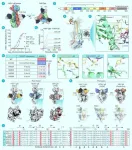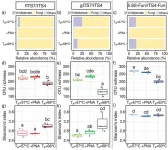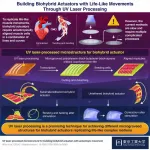The structure of HSV-1 gB bound to a potent neutralizing antibody reveals a conservative antigenic domain across herpesviruses
2024-02-26
(Press-News.org)
Human herpesviruses comprise the alpha, beta, and gamma subfamilies and are a widely prevalent group of DNA-enveloped viruses, capable of establishing lifelong latent infections in humans and causing various diseases. Among them, herpes simplex virus (HSV) belongs to the alpha herpesvirus group and infects a wide population, causing symptoms like oral or genital herpes. As an enveloped virus, HSV possesses a series of glycoproteins involved in virus recognition, adhesion, and infection processes. Among these, gB serves as the viral fusion protein, mediating the fusion between the virus and host cell membranes, and it is highly conserved across the entire herpesvirus family. Therefore, gB represents an ideal antiviral drug or antibody target. However, the lack of structural information on neutralizing epitopes for HSV has hindered the design of antibody drugs and vaccine targets.
The research team successfully purified the HSV-1 gB/D48 Fab complex using the 293F expression system. They validated through in vitro binding and neutralization assays that the D48 antibody efficiently neutralized HSV-1 virus infection by binding to gB (Fig. 1B/1C). Subsequently, they resolved the structure of HSV-1 gB bound to D48 at a resolution of 3.04 Å using cryo-electron microscopy (Fig. 1A). The structure revealed that HSV-1 gB consists of five distinct domains (Fig. 1D), with D48 Fab primarily binding to the DII structural domain (Fig. 1E/1F). Specifically, residues R418, D422, N430, H433, and Q438 from the LCDR1, LCDR3, and FR2 of the D48 light chain were found to interact polarly with DII (Fig. 1H), and alanine mutations at these key residues significantly reduced the interaction between HSV-1 gB and D48 (Fig. 1G).
Upon obtaining high-resolution complex structures of neutralizing antibodies bound to HSV-1 gB, the research team performed a parallel comparison of the neutralizing epitopes of HCMV and EBV gB. They found that the neutralizing antibodies SM5-1 for HCMV and 3A3 for EBV also bind to the DII structural domain of gB (Fig. 1I). Further, they discovered the cross-herpesvirus conserved nature of these domains. The footprints of the antibodies' binding were not found to overlap with conserved residues, suggesting the likely existence of antibodies with broad-spectrum neutralizing activity against herpesviruses (Fig. 1J). Additionally, the team compared the structures of the DII domains of HSV, HCMV, and EBV gBs in complex with antibodies to their corresponding pre-fusion conformations. This comparison yielded recombinant structures showing that the DII domain in the pre-fusion conformation retains the ability to bind neutralizing antibodies, indicating a conservative antigenic epitope presentation in both pre-fusion and post-fusion states (Fig. 1K).
In conclusion, this study innovatively proposes that the gB DII domain within the herpesvirus family constitutes a broadly conserved neutralizing epitope structural domain. It highlights the exposure of antigenic epitopes in both pre-fusion and post-fusion conformations, providing crucial insights for the development of broad-spectrum drugs and vaccines against herpesviruses.
See the article:
The structure of HSV-1 gB bound to a potent neutralizing antibody reveals a conservative antigenic domain across herpesviruses
END
[Attachments] See images for this press release:

ELSE PRESS RELEASES FROM THIS DATE:
2024-02-26
As Canada’s flu season collides with record strep A cases and ongoing COVID-19 concerns, a new study is shedding light on our understanding of respiratory immune responses. Scholars from the Research Institute of the McGill University Health Centre (RI-MUHC) have discovered a surprising facet about a century-old vaccine for tuberculosis, Bacillus Calmette Guérin (BCG). The study, published in the journal Nature Immunology, uncovered a previously unknown mechanism that extends the vaccine’s shield to combat influenza A virus—the most prevalent flu strain.
“The immune interactions ...
2024-02-26
Fungi are frequently found both around and within plant tissues (especially in roots) and are involved in both plant nutrient acquisition and resistance to pathogens. Thus, characterizing the diversity and composition of plant-associated fungal communities has been a growing interest in recent years.
High-throughput sequencing (HTS), also called metabarcoding, has become a prominent tool to assess complex microbial communities from environmental samples. However, HTS applied to plant-associated ...
2024-02-26
World hunger is growing at an alarming rate, with prolonged conflicts, climate change, and COVID-19 exacerbating the problem. In 2022, the World Food Programme helped a record 158 million people. On this trajectory, the United Nations’ goal to eradicate hunger by 2030 appears increasingly unattainable. New research at McGill University shines the spotlight on a significant piece of the puzzle: international food assistance.
With no global treaty in place, food aid is guided by a patchwork of international agreements and institutions. Using the concept of a “regime ...
2024-02-26
Ultraviolet-laser processing is a promising technique for developing intricate microstructures, enabling complex alignment of muscle cells, required for building life-like biohybrid actuators, as shown by Tokyo Tech researchers. Compared to traditional complex methods, this innovative technique enables easy and quick fabrication of microstructures with intricate patterns for achieving different muscle cell arrangements, paving the way for biohybrid actuators capable of complex, flexible movements.
Biomimetic robots, which mimic the movements and biological functions of living organisms, are a fascinating area of research that ...
2024-02-26
[Vienna, Feb 26 2024] — Leptospirosis is a globally distributed infectious disease that affects both animals and humans. While the infection is endemic in tropical regions, its incidence seems to increase in temperate regions. The serological diagnostic test used in routine to detect antibodies against the bacteria responsible for the disease performs better when local variants are used. In Austria, however, no locally circulating strain has been available to date. A new study, published in the latest issue of Scientific Reports, has now been able to close this research gap.
"In our study, ...
2024-02-26
Bethesda, MD (Feb. 26, 2024) — The AGA Research Foundation has announced a $1.4 million endowment grant from The Bern Schwartz Family Foundation. The AGA Institute will provide matching support, resulting in a $2.8 million endowment dedicated to advancing basic research in pancreatic cancer, the third leading cause of cancer deaths in the U.S.
The endowment will fund a second AGA-Bern Schwartz Family Fund Research Scholar Award in Pancreatic Cancer. The first award, created in 2013, will also continue. Both awards provide selected early career-investigators with $100,000 per year for three years ...
2024-02-26
Calls to U.S. poison centers involving psilocybin, or “magic mushrooms,” among adolescents and young adults rose sharply after several U.S. cities and states began decriminalizing the hallucinogen, University of Virginia School of Medicine researchers have found.
Psilocybin-related calls more than tripled among teens ages 13-19 from 152 to 464 and more than doubled among adults ages 20-25 from 125 to 294 between 2018 and 2022, according to anonymized data gathered from the National Poison Data System. Local and state efforts to decriminalize the possession, use and cultivation of psilocybin began in May 2019. Oregon and Colorado have decriminalized psilocybin, as ...
2024-02-26
The average researcher thinks they are better than their colleagues at following good research practice. They also think that their own research field is better than other research fields at following good research practice. This is shown in a new study by researchers at Linköping University, Sweden. The results point to a risk of becoming blind to one’s own shortcomings, according to the Linköping researchers.
“The starting point for the project is that there’s a bit of a crisis in the research world. Research misconduct or difficulties to replicate research results have been discovered in many studies. Credibility has been called into question,” ...
2024-02-26
When you get a tattoo, do you know what you’re putting under your skin? According to new Binghamton University research, the ingredient labels on tattoo ink don’t match the actual substances in the bottle.
Produced by the lab of Binghamton Univerity Assistant Professor of Chemistry John Swierk, “What’s in my ink: An analysis of commercial tattoo ink on the U.S. market” was recently published in the journal Analytical Chemistry.
Swierk’s lab explores the potential impact of light on tattoos and their chemical breakdown. Early on, doctoral student Kelli Moseman ...
2024-02-26
As we get older, we may start to notice it takes us longer to find the right words. This can lead to concerns about cognitive decline and dementia.
However, a new study by Baycrest and the University of Toronto suggests that talking speed is a more important indicator of brain health than difficulty finding words, which appears to be a normal part of aging. This is one of the first studies to look at both differences in natural speech and brain health among healthy adults.
“Our results indicate that changes in general talking speed may reflect changes in the brain,” says Dr. Jed Meltzer, ...
LAST 30 PRESS RELEASES:
[Press-News.org] The structure of HSV-1 gB bound to a potent neutralizing antibody reveals a conservative antigenic domain across herpesviruses






